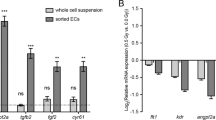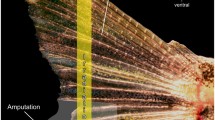Abstract
Proton beam therapy can kill tumor cells while saving normal cells because of its specific energy delivery properties and so is used to various tumor patients. However, the effect of proton beam on angiogenesis in the development of blood vessels has not been determined. Here we used the zebrafish model to determine in vivo whether proton beam inhibits angiogenesis. Flk-1-GFP transgenic embryos irradiated with protons (35 MeV, spread out Bragg peak, SOBP) demonstrated a marked inhibition of embryonic growth and an altered fluorescent blood vessel development in the trunk region. When cells were stained with acridine orange to evaluate DNA damage, the number of green fluorescent cell death spots was increased in trunk regions of irradiated embryos compared to non-irradiated control embryos. Proton beam also significantly increased the cell death rate in human umbilical vein endothelial cells (HUVEC), but pretreatment with N-acetyl cystein (NAC), an antioxidant, reduced the proton-induced cell death rate (p<0.01). Moreover, pretreatment with NAC abrogated the inhibition of trunk vessel development and prevented the trunk malformation caused by proton irradiation. In conclusion, proton irradiation significantly inhibited in vivo vascular development possibly due to increased vascular cell death via reactive oxygen species formation.
Similar content being viewed by others
References
Belli, M., Bettega, D., Calzolari, P., Cera, F., Cherubini, R., Dalla Vecchia, M., Durante, M., Favaretto, S., Gialanella, G., Grossi, G., Marchesini, R., Moschini, G., Piazzola, A., Poli, G., Pugliese, M., Sapora, O., Scampoli, P., Simone, G., Sorrentino, E., Tabocchini, M. A., Tallone, L., and Tiveron, P., Inactivation of human normal and tumour cells irradiated with low energy protons. Int. J. Radiat. Biol., 76, 831–839 (2000).
Bettega, D., Calzolari, P., Chauvel, P., Courdi, A., Herault, J., Iborra, N., Marchesini, R., Massariello, P., Poli, G. L., and Tallone, L., Radiobiological studies on the 65 MeV therapeutic proton beam at Nice using human tumour cells. Int. J. Radiat. Biol., 76, 1297–303 (2000).
Brunner, T. B., Gupta, A. K., Shi, Y., Hahn, S. M., Muschel, R. J., McKenna, W. G., and Bernhard, E. J., Farnesyltransferase inhibitors as radiation sensitizers. Int. J. Radiat. Biol., 79, 569–576 (2003).
Brunner, T. B., Hahn, S. M., McKenna, W. G., and Bernhard, E. J., Radiation sensitization by inhibition of activated Ras. Strahlenther Onkol., 180, 731–740 (2004).
Cerimele, F., Battle, T., Lynch, R., Frank, D. A., Murad, E., Cohen, C., Macaron, N., Sixbey, J., Smith, K., Watnick, R. S., Eliopoulos, A., Shehata, B., and Arbiser, J. L., Reactive oxygen signaling and MAPK activation distinguish Epstein-Barr Virus (EBV)-positive versus EBV-negative Burkitt’s lymphoma. Proc. Natl. Acad. Sci. U.S.A., 102, 175–179 (2005).
Chadderton, N., Cowen, R. L., Sheppard, F. C., Robinson, S., Greco, O., Scott, S. D., Stratford, I. J., Patterson, A. V., and Williams, K. J., Dual responsive promoters to target therapeutic gene expression to radiation-resistant hypoxic tumor cells. Int. J. Radiat. Oncol. Biol Phys,. 62, 213–222 (2005).
Chan, J., Bayliss, P. E., Wood, J. M., and Roberts, T. M., Dissection of angiogenic signaling in zebrafish using a chemical genetic approach. Cancer Cell., 1, 257–267 (2002).
Concin, N., Stimpfl, M., Zeillinger, C., Wolff, U., Hefler, L., Sedlak, J., Leodolter, S., and Zeillinger, R., Role of p53 in G2/ M cell cycle arrest and apoptosis in response to gamma-irradiation in ovarian carcinoma cell lines. Int J Oncol., 22, 51–57 (2003).
Di Pietro, C., Piro, S., Tabbi, G., Ragusa, M., Di Pietro, V., Zimmitti, V., Cuda, F., Anello, M., Consoli, U., Salinaro, E. T., Caruso, M., Vancheri, C., Crimi N., Sabini, M.G., Cirrone, G. A., Raffaele, L., Privitera, G., Pulvirenti, A., Giugno, R., Ferro, A., Cuttone, G., Lo Nigro, S., Purrello, R., Purrello, F., and Purrello, M., Cellular and molecular effects of protons: apoptosis induction and potential implications for cancer therapy. Apoptosis, 11, 57–66 (2006).
el Gamoussi, R., Stratford, I. J., and Guichard, M., Relationship between intracellular concentration and radiosensitizing effect of pimonidazole and etanidazole on two human melanoma cell lines. Int J Radiat Biol., 63, 27–36 (1993).
Engel, R.H. and Evens, A.M., Oxidative stress and apoptosis: a new treatment paradigm in cancer. Front Biosci., 11, 300–312 (2006).
Folkman, J., Angiogenesis and its inhibitors. Important Adv Oncol., 42–62 (1985).
Giuliano, M., Lauricella, M., Vassallo, E., Carabillo, M., Vento, R., and Tesoriere, G., Induction of apoptosis in human retinoblastoma cells by topoisomerase inhibitors. Invest Ophthalmol Vis Sci., 39, 1300–1311 (1998).
Haffter, P., Granato, M., Brand, M., and Mullins, M. C., The identification of genes with unique and essential functions in the development of the zebrafish, Danio rerio. Development., 123, 1–36 (1996).
Harris, A. L., Hypoxia-a key regulatory factor in tumour growth. Nat Rev Cancer, 2, 38–47 (2002).
Hashimoto, T., Tokuuye, K., Fukumitsu, N., Igaki, H., Hata, M., Kagei, K., Sugahara, S., Ohara, K., Matsuzaki, Y., and Akine, Y., Repeated proton beam therapy for hepatocellular carcinoma. Int. J. Radiat. Oncol. Biol. Phys., 65, 196–202 (2006).
Isenberg, J. S., Jia, Y., Field, L., Ridnour, L. A., Sparatore, A., Del Soldato, P., Sowers, A. L., Yeh, G. C., Moody, T. W., Wink, D. A., Ramchandran R., and Roberts D. D., Modulation of angiogenesis by dithiolethione-modified NSAIDs and valproic acid. Br J Pharmacol., 151, 63–72 (2007).
Jabs, T., Reactive oxygen intermediates as mediators of programmed cell death in plants and animals. Biochem Pharmacol., 57, 231–245 (1999).
Kari, G., Rodeck, U., and Dicker, A.P., Zebrafish: an emerging model system for human disease and drug discovery. Clin Pharmacol Ther., 82, 70–80 (2007).
Kennedy, A. R., Guan, J., and Ware, J. H. Countermeasures against space radiation induced oxidative stress in mice. Radiat Environ Biophys., 46, 201–203 (2007).
Kimmel, C. B., Ballard, W. W., Kimmel, S. R., Ullmann, B., and Shilling, T. F., Stages of embryonic development of the zebrafish. Devopmental. Dyn., 203, 253–310 (1995).
Langheinrich, U., Zebrafish: a new model on the pharmaceutical catwalk. Bioessays., 25, 904–912 (2003).
Lee, K. B., Lee, J. S., Park, J. S., Huh, T. L., and Lee, Y. M., Low energy proton beam induces tumor cell apoptosis through reactive oxygen species and activation of caspases. Exp. Mol. Med., 40, 118–129 (2008).
Levin, W. P., Kooy H., Loeffler J. S., and DeLaney T. F., Proton beam therapy. Br.J.Cancer 93, 849–854 (2005).
Li, L. and Dowling, J. E., A dominant form of inherited retinal degeneration caused by a non-photoreceptor cell-specific mutation. Proc. Natl. Acad. Sci. U.S.A., 94, 11645–11650 (1997).
Limoli, C. L., Giedzinski, E., Baure, J., Rola, R., and Fike, J. R., Redox changes induced in hippocampal precursor cells by heavy ion irradiation. Radiat Environ Biophys, 46, 167–172 (2007).
Mishra, K. P., Cell membrane oxidative damage induced by gamma-radiation and apoptotic sensitivity. J Environ Pathol Toxicol Oncol. 23, 61–66 (2004).
Sanchez-Prieto, R., Rojas, J. M., Taya, Y., and Gutkind, J. S., A role for the p38 mitogen-acitvated protein kinase pathway in the transcriptional activation of p53 on genotoxic stress by chemotherapeutic agents. Cancer Res., 60, 2464–2472 (2000).
Seiler, C. and Nicolson, T., Defective calmodulin-dependent rapid apical endocytosis in zebrafish sensory hair cell mutants. J Neurobiol., 41, 424–434 (1999).
Semenza, G. L., Intratumoral hypoxia, radiation resistance, and HIF-1α. Cancer Cell. 5, 405–406 (2004).
Taraboletti, G. and Giavazzi, R., Modelling approaches for angiogenesis. Eur. J. Cancer., 40, 881–889 (2004).
Wan, X. S., Zhou, Z., Ware, J. H., and Kennedy, A. R., Standardization of a fluorometric assay for measuring oxidative stress in irradiated cells. Radiat Res., 163, 232–240 (2005).
Westerfield, M., The zebrafish book. A guide for the laboratory use of zebrafish (Danio rerio). (3rd ed.), University of Oregon Press, Eugene (1995).
Williams, K. J., Telfer, B. A., Xenaki, D., Sheridan, M. R., Desbaillets, I., Peters, H. J., Honess, D., Harris, A. L., Dachs, G. U., van der Kogel, A., and Stratford, I. J., Enhanced response to radiotherapy in tumours deficient in the function of hypoxia-inducible factor-1. Radiother Oncol., 75, 89–98 (2005).
Yabu, T., Tomimoto, H., Taguchi, Y., Yamaoka, S., Igarashi, Y., and Okazaki, T., Thalidomide-induced antiangiogenic action is mediated by ceramide through depletion of VEGF receptors, and is antagonized by sphingosine-1-phosphate. Blood, 106, 125–134 (2005).
Author information
Authors and Affiliations
Corresponding author
Rights and permissions
About this article
Cite this article
Jang, G.H., Ha, JH., Huh, TL. et al. Effect of proton beam on blood vessel formation in early developing zebrafish (Danio rerio) embryos. Arch. Pharm. Res. 31, 779–785 (2008). https://doi.org/10.1007/s12272-001-1226-1
Received:
Revised:
Accepted:
Published:
Issue Date:
DOI: https://doi.org/10.1007/s12272-001-1226-1




